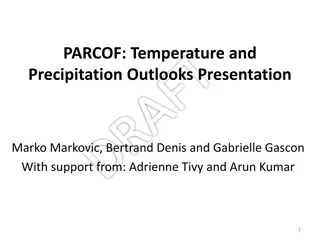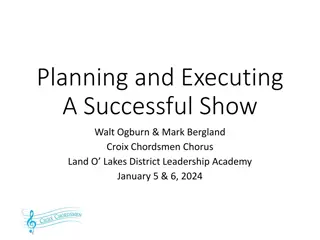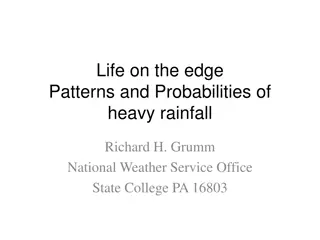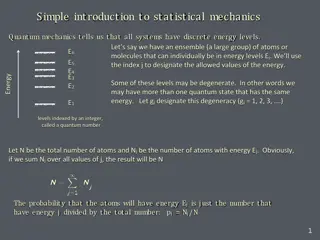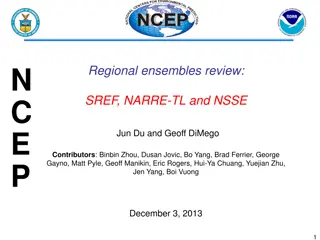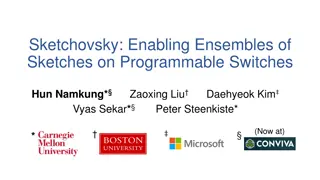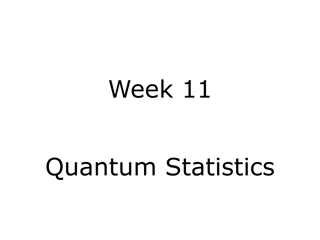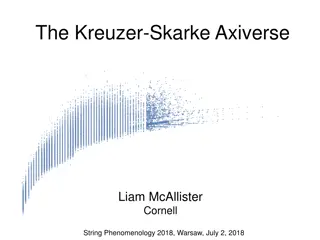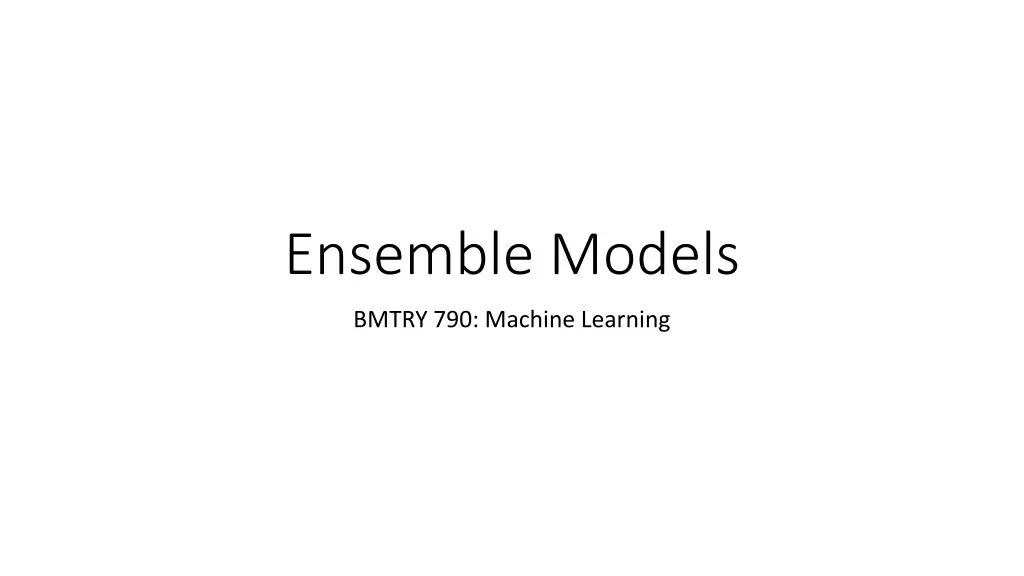
Understanding Ensemble Models and Boosting Algorithms
Learn about ensemble models like Boosting that combine multiple classifiers to improve predictive accuracy in machine learning. Discover how Boosting Algorithm (AdaBoost) works by iteratively fitting weak classifiers to training data and adjusting observation weights based on prediction errors.
Uploaded on | 3 Views
Download Presentation

Please find below an Image/Link to download the presentation.
The content on the website is provided AS IS for your information and personal use only. It may not be sold, licensed, or shared on other websites without obtaining consent from the author. If you encounter any issues during the download, it is possible that the publisher has removed the file from their server.
You are allowed to download the files provided on this website for personal or commercial use, subject to the condition that they are used lawfully. All files are the property of their respective owners.
The content on the website is provided AS IS for your information and personal use only. It may not be sold, licensed, or shared on other websites without obtaining consent from the author.
E N D
Presentation Transcript
Ensemble Models BMTRY 790: Machine Learning
Ensemble Models One of the most notable improvements in CART came with the advent of ensemble learners Ensemble Models: Build a classification or prediction model from a group of simple base models (e.g. CART) The committee of models each cast a vote for: Predicted class (for classification) Mean response (for regression) For classification, predicted class is decided by a majority vote For regression, is the average predicted value across models y
Ensemble Approaches Boosting Sequentially apply a weak classification algorithm (i.e. CART) to repeatedly modified version of training data to yield a set of weighted classifiers Bagging (bootstrap aggregating) Draw repeated bootstrap samples from training data and apply weak classification algorithm to each bootstrap sample to yield a collection of weak classifiers Randomization Repeatedly select random subsets of the predictors/features from the data an construct weak classifiers for each subset of predictors to yield a collection of weak classifiers
On Boosting Consider error on some training data ( ) ( ) N = err I y G x 1 N i i = 1 i G(xi) is a weak classifier from which we make a prediction for observation xi , i = 1,2, ,N Boosting develops set of weak classifiers, Gm(xi), m = 1,2, ,M, on repeatedly modified versions of a training data set Predictions are based on weighted predictions from the M classifiers Algorithm originally designed for classification of a binary response 11 , Y Note requires coding of the response as:
Boosting Algorithm (AdaBoost) (1) Initialize observation weights (2) For m = 1 to M (a) Fit a classifier Gm(x) to the training data using weights wi ( ) = ( ) x N wI y G ( ) m i i m i = 1 i err (b) Compute: N w i = 1 i ( ) m 1 err err exp = log (c) Compute: ( ) m m ( ) ( ) x = 1 2 , ,...,N i,new w w I y G , i (d) Set : i,old m i m i ( ) ( ) ( ) x M = (3) Output from the boosted ensemble is given by: sign G x G m m = 1 m
Boosting Weights Classifier weights: The boosting estimated a weight for each classifier in the set of Gm(xi), m = 1, 2, ,M, classifiers Note: Estimation of m, assumes err(m)< Classifiers yielding smaller weighted error during fitting receive a higher weight than more poorly fitting classifiers ( ) m 1 err err = log ( ) m m Thus more accurate classifiers in the set Gm(xi) have more say in the final prediction ( ) sign m G x ( ) ( ) x M = G m m = 1
Boosting Weights Observation Weights: Boosting also weights the N observations in the training at each repetition m Before fitting any classifiers, we have no idea which observations are more difficult to classify so all have the same starting weight 1, N = = 1,2,..., iw i N 1
Boosting Weights Observation weights: As we fit successive models, observations correctly classified in model Gm(xi) are down weighted when fitting model Gm+1(xi) Similarly, observations that are incorrectly classified are up weighted in when the next model is fit i,new i,old m w w exp ( ) ( ) x = 1 2 , ,...,N I y G , i i m i NOTE: Although boosting weights the N observations in the training data for each classifier Gm(xi), only the classifier specific weights mare used when predicting new observations
Adaptations of AdaBoost Boosting was initially developed for solving a two class problem What if there are > 2 classes? One solution is to fit a two class model to each pair of classes This can be extremely difficult given the constraint that estimation of m assumes err(m)<
SAMME Algorithm AKA: Stagewise Additive Modeling using a Multi-Class Exponential Loss Function (1) Initialize observation weights (2) For m = 1 to M (a) Fit a classifier Gm(x) to the training data using weights wi ( ) = ( ) x N wI y G ( ) m i i m i = 1 i err (b) Compute: N w i = 1 i ( ) m 1 err err exp ( ) = + 1 log log K (c) Compute: ( ) m m ( ) ( ) x = (d) Set : 1 2 , ,...,N i,new w w I y G , i i,old m i m i (3) Output from the boosted ensemble is given by: ( ) ( ) ( ) x M = sign G x G m m = 1 m
Why does SAMME work Friedman, Hastie and Tibshirani (2000) showed boosting is the same as fitting a forward stagewise additive model with an exponential loss function ( ) ( ( ) argmin f = x ( ) ( ) x yf = x L y, f e ) ( ) = = = where: class 1 class 1 y I I ( ) ( ) x E L y, f ( ) ( ( = X x Y| x f ) 1 = Prob class 1 Prob class = log 1 2 ) = SAMME is an extension of this idea but using a multi-class exponential loss function
A Little More on Boosting Boosting can be applied to any classifier, though most useful for weak learners Linear regression classifier Logistic regression CART The most common base models are CART trees When using CART we can still consider tree size Still want to avoid over-fitting of individual trees Pruning can be employed (just as in CART)
A Little More on Boosting If CART is the base model, the posterior probability is estimated by the proportion of trees that predict a particular class Certainty about the predicted class is defined as the margin The margin in boosting is estimated by the difference between the support for the correct class and the maximum support for the incorrect class
Bootstrap Aggregating (bagging) Bagging (bootstrap aggregating) also develops set of weak classifiers, Gm(xi), m= 1,2, ,M Unlike boosting, bagging does not use all of the data for each classifier Rather it uses a subset of the data (i.e. a bootstrap sample) and construct a model for each subset of the data randomly selected by the algorithm
Bagging Predictions from a bagged ensemble are made based on a majority vote from the M classifiers Each tree casts a vote for the class of a new observation Class receiving the most votes is the predicted class Also unlike boosting, all votes receive equal weight
Bagging Algorithm Given some data W = (y, x), that includes i= 1,2, , N observations on a vector of predictors, xi, and response variable yi that is in 1 of K classes (1) For b= 1 to B (a) From data W = (y, x), draw a bootstrap sample of size N yielding training data Wb = (yb, xb) (b) Fit a classifier Gb(x) to the training data Wb = (yb, xb) (2) Output from the bagged ensemble is given by: ( ) ( ) x ( ) x B = = I G argmax k G k b = 1 b
Out-of-Bag Data Drawing B repeated bootstrap samples from a single data set yields B unique sets of data Approximately 37% of the N observations (y, x) are omitted from the bth bootstrap data set These omitted data are referred to as out-of-bag (OOB) data and can be treated as independent test data We can use each classifier in a bagged ensemble to make a prediction on its OOB to get an unbiased estimate of model error ( ) x I G = k b i ( ) x ( ) i x OOB prediction for observation i = argmax k G i OOBb i B OOB I i OOB b = 1 b ( ) N OOB error is = err I y G 1 N OOB i = OOB 1 i
Comments on Bagging Bagging has the advantage of having built-in test data to estimate model error rate (in an unbiased fashion) It has also been shown that sub-sampling can be used as an alternative to bagging, select a subset of the data without replacement Yields similar improvements bagging Generally suggest selecting 63% of data when drawing the subset (similar number of unique observations to bagging) Some suggests this is preferable since observations are not included more than once in any given dataset
Comments on Boosting and Bagging Both boosting and bagging are effective at variance reduction However, boosting has also been shown to reduce bias (where as bagging does not) Bagging is more computationally efficient than boosting in general
Randomization The previous methods focus on specific observations in the data Boosting: adaptively reweight observations Bagging: select bootstrap samples of observations Randomization focuses on predictors (columns NOT rows) Each classifier Gm(xi) is constructed on the full training data But uses a random subset of the predictors (rather than a subset of observations) when constructing Gm(xi) Predictions are made using the same formula as for bagging This method is rarely used by itself
Random Forest One of the most popular ensemble methods is Random Forest Random forest combines bagging and randomization Usually has better performance compared to single model counterpart Also usually better computing speed relative to boosting and bagging Generates out-of-bag (OOB) data for some very useful purposes
Bagging vs. Boosting In bagging, idea was to reduce variance by averaging a large number of unbiased models (i.e. decision trees) Trees good because they can model complex interactions Also have low bias if grown sufficiently large Trees generated by bagging are identically distributed (i.d.) Comparison with boosting Boosting idea was to adaptively fit trees to remove bias This approach leads to trees that are not i.d.
Random Forest vs. Bagging Consider in bagging we have Bi.d. random variables with variance 2 If they are also independent, averaging yields variance 2/B If they are not independent but rather have pairwise correlation , then the variance of the average is 2 + 2 (1- )/B Idea of Random Forest In bagging, as correlation increase we loose the benefit of averaging Thus the idea in random forest is to reduce the correlation without increasing variance very much So let s look at the algorithm
Random Forest Algorithm Given training data W = (y, x), with i=1,2, , N observations on p predictors in xiand a response, yi (1) For b = 1 to B (a) From data W = (y, x), draw a bootstrap sample of size N yielding training data Wb = (yb, xb) (b) Fit a CART classifier Gb(x) to the training data Wb = (yb, xb) BUT At each step of the recursive partitioning algorithm (i) Randomly select a subset of size jfrom the p predictors (ii) Determine the best split from among the j predictors (iii) Grow CART tree to perfect fit (i.e. NO PRUNING) (2) Output from a random forest ensemble (for classification) is given by: ( ) argmax b k ( ) ( ) x B = = I G x G k b = 1
Fitting CART Tree within RF Assume we have data W = (y, x) with N observations and 10 predictors Random forest algorithm selects bootstrapped sample of the data to yield training set Wb with N observations In the first step of constructing the CART tree for data Wb, RF randomly selects predictors X1, X3, X4, X5, and X7 The recursive partitioning algorithm then selects the best split among these 5 predictors
Fitting CART Tree within RF Let s say from among predictors X1, X3, X4, X5, and X7 X1 < 4 provides best split X1 < 4 For the next split (branch going left) random forest algorithm randomly selects a new subset of predictors: X1, X2, X7, X9, and X10 ?
Fitting CART Tree within RF The recursive partitioning algorithm then selects the best split for this branch from among the 5 selected predictors X1 < 4 Let s say X9 < 2 provides best split X9 < 2 For the next split (branch going right from the first split) random forest algorithm randomly selects a new subset of predictors: X2, X4, X5, X7, and X8
Fitting CART Tree within RF Again the recursive partitioning algorithm then selects the best split for this branch from among the 5 selected predictors X1 < 4 X9 < 2 X2 < 20 Let s say X2 < 20 provides best split This process will be repeated until the CART tree perfectly fit training data Wb
How Many Variables to Consider at Each Split? When RF was developed, simulations were conducted to provide guidance as to the number of variables considered at a split The recommendations are = Regression: m p p m = Classification: 3 In practice, these should be considered as tuning parameters
Margin in Random Forest As was true with boosting, the posterior probability is estimated by the proportion of trees that predict a particular class In random forest, the margin is the difference between the proportion of votes for the correct class and the maximum proportion for an incorrect class Thus a margin value > 0 indicates a correctly predicted class under the majority votes assumption
Out-of-Bag Data As with bagging, we end up with an OOB sample for each tree in our forest Also like bagging we can use these OOB data to obtain an unbiased estimate of model error However, with random forest we also get an additional feature A variable importance measure Note: there is a less well developed importance measure developed for boosting based on the gain in Gini index given by a variable in the each tree and the weight of the tree
Out of Bag Error Rate Since the OOB for tree Gb(x) are not used in building the tree, these data can be considered as test data for the bth tree We can use this fact to develop an estimated error rate for the forest Observation xiis included in ~ 1/3 of OOB datasets OOB error rate: Estimate the predicted class for all observations in the data based on only those trees for which they were out-of-bag Compare the OOB predicted value to the observed value Average the sum of the errors over all observations ( 1 OOB i N i err I y G = ) ( ) x N = 1 i OOB In general, the result is an unbiased estimate of the test error rate
Variable Importance Measure for RF Estimate model error using the OOB data according to ( ) ( ) x N = err I y G 1 N OOB i i = OOB 1 i ( ) ( ) j i Randomly permute column for Xjyielding data = x W y , i Estimate model error on the OOB data again but with column Xj randomly permuted ( ) ( 1 i ) ( ) ( ) j i N j = x err I y G 1 N OOB i = OOB Variable importance is measured as the difference between post and pre- permuted data ( ) j OOB = VariableImportancefor X err err j OOB
Proximity Measure An additional feature from RF that can be estimated using the OOB data is the proximity (i.e. similarity) between observations For every tree in the RF, a pair of OOB observations sharing the same terminal node will increase their proximity by 1 When evaluated across the B trees, the result is an N x Nproximity matrix quantifying the proximity of any pair of observations Idea is that similarity between observations, even high dimensional data can be represented graphically based on proximity
AdaBoost in R Many R packages for Boosted CART models (here are a few) adabag Fits Adaboost and SAMME models for classification Will also fit bagged models ada: Fits AdaBoost models using stochastic gradient descent algorithm Doesn t have capability to fit multi-class model others fastAdaboost, mboost, gmb Plus others that fit boosted models using based models other than decision trees So let s consider and example
Lupus Nephritis Example: Treatment response in patients with treatment response Data include 280 observations examining treatment response at 1 year in patient with lupus nephritis Data includes Demographics: Treatment response: Clinical Markers: Urine markers: age, race Yes/No c4c, dsDNA, EGFR, UrPrCr IL2ra, IL6, IL8, IL12
A Quick Note on Training a Boosted Model Since AdaBoost and SAMME models are composed of a set of decision trees, pruning of trees can (and should) be applied Think of trees as a set of interactions (aka the branches) Trees with only 1 split = main effects Very large trees = complex interactions among many predictors Main focus of pruning in boosting is to restrict tree size
A Quick Note on Training a Boosted Model In practice, many data can be reasonably well explained by lower- order interactions Simulations have found that selecting maximum tree sizes between 4 to 8 terminal nodes often works well Appears to fairly insensitive and not overly noisy in fit This choice yields trees sizes between 2 to 6 levels i.e. max depth between 2-6 Thus this is a good starting point for tuning the model prior to final fit
A Quick Note on Training a Boosted Model On also can consider the number of trees, M, in the boosted model during training As boosting progresses, the reduction in training risk can become very small Choosing M too large can result in overfitting One approach: monitor impact of M on a validation sample Alternatively, shrinkage approaches (think ridge and lasso regression) have also been developed to avoid overfitting Adapt the gradient descent algorithm to include a shrinkage parameter
Stochastic Gradient Descent for Boosting ( ) F x = 0 (1) Initialize the model: (2) For m = 1 to M ( ) ( ) ( ) L y,F x F x = = yf where w L y, f e (a) Set weights ( ) i (b) Fit y = (Gm(x)) to the training data using weights wi ( ) ( ) ( ) ( ) ( ) x = + arg min ( ) x = L y ,F x G (c) Compute: m i m i ( ) ( ) x + new F F x G (d) Update: m m i ( ) ( ) ( ) x ( ) ( = = = x sign x (traditionalAdaBoost) can be ) x log x 1 2 x (realBoost) 1 x (gentalBoost) is the penalty parameter/learning rate
Fitting AdaBoost using adabag ### First looking at adabag package for boosting library(adabag) LN<-read.csv("H:/public_html/BMTRY790_Spring2023/Datasets/LupusNephritis.csv") ids1<-which(LN$CR90==1) ids0<-which(LN$CR90==0) LN$CR90<-as.factor(ifelse(LN$CR90==1, "Class1","Class0")) trn1<-sample(ids1, .67*length(ids1), replace=F) trn0<-sample(ids0, .67*length(ids0), replace=F) sub<-sort(c(trn1, trn0))
Training AdaBoost (adabag) ### Choose model fitting parameters using caret (this is computationally slow...) grid <- expand.grid(mfinal=c(100, 250, 500), maxdepth = c(2:6), coeflearn = "Freund") trBoost1<-train(CR90~., data=LN, method="AdaBoost.M1", tuneGrid=grid, trControl=trainControl(method = "cv", number = 10, classProbs = TRUE)) trBoost1 AdaBoost.M1 280 samples 10 predictor 2 classes: 'Class0', 'Class1' No pre-processing Resampling: Cross-Validated (10 fold) Summary of sample sizes: 224, 224, 223, 224, 225, ... Resampling results across tuning parameters: maxdepth mfinal Accuracy Kappa 2 50 0.7654944 0.3568077 2 100 0.7436782 0.2997448
Training AdaBoost (adabag) ### Choose model fitting parameters using caret (this is computationally slow...) trBoost1 maxdepth mfinal Accuracy Kappa 5 100 0.7617816 0.3246032 5 250 0.7901341 0.4116736 6 50 0.7621784 0.3363356 6 100 0.7763592 0.3701187 6 250 0.7863072 0.3915330 Tuning parameter 'coeflearn' was held constant at a value of Freund Accuracy was used to select the optimal model using the largest value. The final values used for the model were mfinal = 250, maxdepth = 5 and coeflearn = Freund.
Fitting AdaBoost (adabag) ### Fitting model using selected parameters BoostMod1<-boosting(CR90~., data=LN[sub,], boos=F, coeflearn="Freund", mfinal=250, control=rpart.control(maxdepth=5)) #Note calls rpart so you can set the control parameters for the trees names(BoostMod1) [1] "formula" "trees" "weights" "votes" "prob" "class" "importance" "terms" "call BoostMod1$trees[[1]] n= 187 node), split, n, loss, yval, (yprob), * denotes terminal node 1) root 187 0.26203210 Class0 (0.88803917 0.11196083) 2) urprcr>=0.657 133 0.12834220 Class0 (0.92748798 0.07251202) 4) il2ra>=396.65 90 0.05882353 Class0 (0.95288873 0.04711127) * 5) il2ra< 396.65 43 0.06951872 Class0 (0.86665271 0.13334729) 10) age>=22.5 34 0.03208556 Class0 (0.92929293 0.07070707) * 11) age< 22.5 9 0.01069519 Class1 (0.44588045 0.55411955) * 3) urprcr< 0.657 54 0.13368980 Class0 (0.76563995 0.23436005) 6) il8< 52.25 40 0.06951872 Class0 (0.85399954 0.14600046) 12) egfr< 85.0055 14 0.00000000 Class0 (1.00000000 0.00000000) * 13) egfr>=85.0055 26 0.06951872 Class1 (0.73796791 0.26203209) 26) age>=22.9 18 0.03743316 Class0 (0.81569049 0.18430951) * 27) age< 22.9 8 0.01069519 Class1 (0.48421053 0.51578947) * 7) il8>=52.25 14 0.01069519 Class1 (0.31944444 0.68055556) *
Compare 1st and 125th Tree 1) root 187 0.2620 Class0 (0.8880 0.1120) 2) urprcr>=0.657 133 0.1283 Class0 (0.9275 0.0725) 4) il2ra>=396.65 90 0.0588 Class0 (0.9529 0.0471) * 5) il2ra< 396.65 43 0.0695 Class0 (0.8667 0.1333) 10) age>=22.5 34 0.0321 Class0 (0.9293 0.0707) * 11) age< 22.5 9 0.0107 Class1 (0.4459 0.5541) * 3) urprcr< 0.657 54 0.1337 Class0 (0.7656 0.2344) 6) il8< 52.25 40 0.0695 Class0 (0.8540 0.1460) 12) egfr< 85.0055 14 0.0000 Class0 (1.0000 0.0000) * 13) egfr>=85.0055 26 0.0695 Class1 (0.7380 0.2620) 26) age>=22.9 18 0.0374 Class0 (0.8157 0.1843) * 27) age< 22.9 8 0.01070 Class1 (0.4842 0.5158) * 7) il8>=52.25 14 0.01070 Class1 (0.3194 0.6806) * 1) root 187 0.4251 Class0 (0.6465 0.3535) 2) egfr>=131.544 33 0.0530 Class0 (0.8569 0.14307) * 3) egfr< 131.544 154 0.3399 Class1 (0.5527 0.4473) 6) egfr< 121.3625 139 0.2634 Class0 (0.6303 0.3697) 12) egfr>=109.967 21 0.0078 Class0 (0.9530 0.0470) * 13) egfr< 109.967 118 0.2153 Class1 (0.5326 0.4674) 26) il2ra< 187.35 18 0.0069 Class0 (0.8954 0.1046) * 27) il2ra>=187.35 100 0.1715 Class1 (0.4826 0.5174) 54) c4c>=21.95 32 0.0121 Class0 (0.8377 0.1623) * 55) c4c< 21.95 68 0.1253 Class1 (0.4171 0.5826) * 7) egfr>=121.3625 15 0.0079 Class1 (0.0894 0.9106) *
Properties of AdaBoost (adabag) ### What about other information on the model? round(BoostMod1$weights, 3) [1] 1.655 1.653 1.142 1.621 1.482 1.423 1.072 1.904 1.659 1.906 1.472 1.078 1.744 1.407 1.440 1.281 1.397 1.558 [19] 1.571 1.456 1.142 1.476 1.603 1.320 1.663 1.004 1.500 1.335 1.561 1.686 2.145 1.823 2.014 1.712 2.115 1.896 ... [235] 1.949 1.692 1.209 1.459 1.365 1.308 1.140 1.336 1.588 1.699 0.815 1.478 1.715 1.181 1.289 1.342 BoostMod1$votes [,1] [,2] [1,] 281.889 119.554 [2,] 278.586 122.857 [3,] 273.943 127.501 [4,] 275.091 126.352 [185,] 128.209 273.234 [186,] 127.785 273.659 [187,] 126.637 274.806
Working Through an Iteration Recall the AdaBoost algorithm: (1) Initialize observation weights (2) For m = 1 to M (a) Fit a classifier Gm(x) to the training data using weights wi ( ) = ( ) x N wI y G ( ) m i i m i = 1 i err (b) Compute: N w i = 1 i ( ) m 1 err err = log (c) Compute: ( ) m m ( ) ( ) x = 1 2 , ,...,N i,new w w exp I y G , i (d) Set : i,old m i m i ( ) ( ) ( ) x M = sign G x G (3) Output from the boosted ensemble is given by: m m = 1 m
Working Through an Iteration For the first iteration (1) Observation weights? (2) Build G1(x) = (3) Estimate error (30 observations misclassified of 187)









